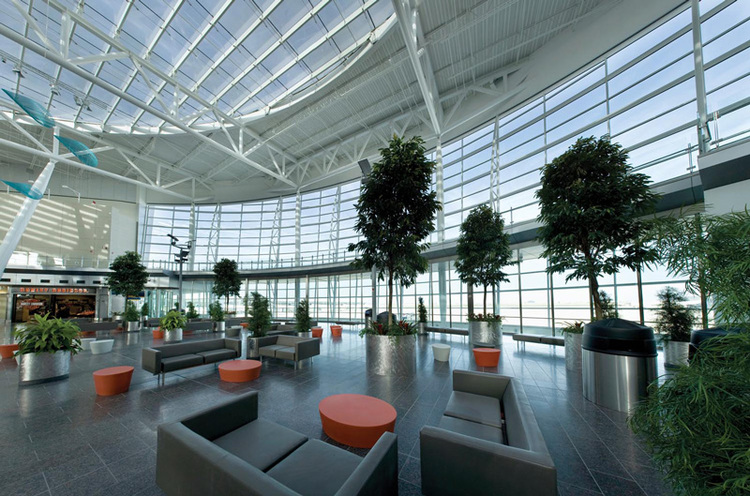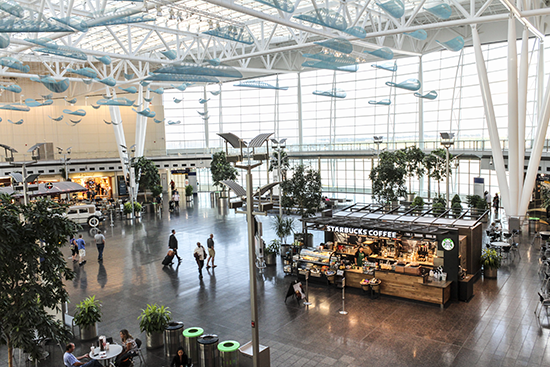IND TERMINAL DESIGN
With striking architecture and efficient operations, it is no wonder that exceptional service has become an award-winning hallmark of the Indianapolis International Airport (IND). But it’s the action behind the scenes that makes the Col. H. Weir Cook Terminal a national leader in creating a healthy environment that will sustain future generations, promote economic prosperity, and conserve natural resources.
The Mid-Field Terminal is the first entire airport to be LEED® Certified™ by the U.S. Green Building Council (USGBC). LEED®, Leaders in Energy and Environmental Design, is a rating system which recognizes sustainable measures taken during the design, development, construction, and operation of a structure. The airport represents Indianapolis' ongoing commitment to sustainable innovations in energy efficiency and environmental protection. The Indianapolis Airport Terminal has received 29 credits in the following categories:

Roof Design
Floor-Level Heating & Cooling
Energy-Efficient Equipment
Air & Water Control Monitoring Systems
Construction-Material Recycling
Regionally-Sourced Materials
Forest Stewardship Council (FSC) Certified Wood
No Smoking Policy
Monitored Air-Ventilated System
Natual Daylighting
Outdoor Views
Low Impact Construction
Clean Stormwater
Mass Transit Accessibility
10% Electricity Reduction
25% Natural Gas Reduction
Radiant Heating
Garage Relighting
Water-Efficient Fixtures
Water Consumption Monitoring
Leak Detection Monitoring
35% Water Reduction
The IND terminal has many innovative design features not seen in most terminals. By far the most prominent, the roof design incorporates skylights and windows to provide 75% natural daylighting in the terminal. This reduces electrical costs as well as providing users with a more positive attitude. The roof reduces cooling costs by providing shade and reflecting radiant heat from the sun.
reduction
reduction
reduction
of terminal lighting
100%
75%
50%
25%
0

The demolition of the old terminal project in 2013 produced a lot of construction waste. In order to meet LEED® standards for construction waste the IAA successfully recycled or reused 87% of the old terminal’s materials. This consisted of over 97,000 ton of concrete and 7,838 tons of miscellaneous metals. Approximately 7,000 tons of the old taxiway was crushed and for site fill. Approximately 14,717 tons of general debris (and asbestos containing material) were taken to a landfill for disposal. The amount of materials reused or recycled offset the amount of debris that was disposed in landfills. The overall use of recycled materials during construction exceeded 27%. This reduced the need for raw materials, which also helps to reduce energy and fuel needed to create and transport new materials.
More than 90% of new “raw” materials used for construction came from manufacturers located within a 500-mile radius. 68% of these manufacturers are regionally-sourced. This helps to promote local businesses and economical practices as well as reducing negative impacts on the environment from long-haul transportation. 63% of the wood construction is certified from the Forest Stewardship Council® (FSC®). The FCS promotes responsible forest management globally by certifying forest products that meet rigorous sustainable forestry standards. This helps to prevent deforestation, prohibits harvesting of rare old-growth forests, and protects forests for future generations.
The heating and cooling system of the terminal consists of using a radiant system. This system uses floor-level pipes to heat the floors and the comfort area that impact visitors. This method is more efficient than the traditional systems in energy usage as well as comfort area coverage. Since the floor-pipes are only heating the areas occupied, energy is reduced by 21%. This reduction is achieved by the fact that heat rises naturally. The typical vented system has to force air down to the floor levels where the heat does not ever reach the floor causing a cold draft around a person’s feet. Comfort levels are continuously monitored in order to maintain temperature and humidity within the terminal.
The heating and cooling system is not the only thing that helps bring comfort to visitors. The terminal also has established a standard to protect the quality of indoor air. This set standard includes a campus-wide no smoking policy as well as an automatic air monitoring system. The automatic air monitors check the levels of carbon dioxide and other contaminants in real time and then automatically adjusts the ventilation to allow for fresh air. Dust control procedures are also used at entryways to help reduce contaminants.
When it comes to indoor environmental quality we must also think in terms of the well-being of a person or the mindset it emplaced. LEED® gives credit to IND for achieving comfort levels with the use of natural daylighting and outdoor views. Natural daylighting has a positive psychological effect on a person’s mind compared to artificial lights. Natural daylighting has been proven to create a more positive mood, enhance morale, lower fatigue, and reduce eyestrain. With the terminal being composed of 75% natural daylighting a visitor will typically feel more comfortable and less stressed while waiting on their flight. The terminal provides extensive outside views which promotes positive responses by reducing stress, decreasing anxiety, holding attention, and improving a person’s mood. Also, artwork located throughout the terminal provides positive stimulation for visitors as they wait.
The location of the midfield terminal between the parallel runways has a significant impact on the community. This optimized location reduces runway taxi time by 8 minutes, which helps reduce stress on passengers. This reduction in taxi time has a savings of approximately $1,800 per flight. The terminal location saves approximately 2,500,000 gallons of jet fuel annually, which equates to approximately $6,200,000 savings on jet fuel expenditures. Passengers can also feel at ease that this reduction on the runway also eliminates annual greenhouse emissions of CO2e by 23,925 metric tonnes.
The IAA has also adopted a stormwater management program. The IND campus is capable of collecting 80 million gallons of stormwater and run-off. These basins are used to collect contaminated water from the runways such as hydrocarbon emissions and deicing substances. IND uses a natural filtration system by the use of bioswales with vegetation. The stormwater then mitigates in the basins until contaminate levels are low enough to not have a negative impact on the environment.
The IAA has seen an overall 10% reduction in annual electrical consumption in the terminal. This is achieved by the sustainable initiatives of the IAA to be LEED® Certified™. The IND terminal uses energy efficient equipment and appliances. The window façade and skylights reduces energy cost by providing over 75% natural daylighting. The IND also had a garage relighting program that replaced 1,599 bulbs in the parking garage and Indianapolis Maintenance Center with LED bulbs. The combined annual electrical reduction is approximately $250,000. The electrical reduction also reduces carbon dioxide emissions by 5,233 metric tons. This is equivalent to removing more than 1,000 gas-powered cars from the roads each year.
The heating, ventilating, and air conditioning (HVAC) system used in the terminal has also reduced energy usage. The terminal’s HVAC system is a high efficient system that uses natural gas and radiant heating. The HVAC system’s efficiency has reduced natural gas usage by over 434,000 therms between 2010 and 2013. This 25% reduction of natural gas is enough therms to provide heat for almost 616 average American homes.
The IND terminal uses water saving fixtures to reduce water consumption. The terminal also has a consumption monitoring system to determine where consumption is high, thus suggesting maintenance issues, e.g., correcting a leaky faucet. Another monitoring system the terminal uses to their advantage is a leak detection monitoring system. This system monitors the flow of water through the pipe system and alerts the IAA of any changes in the flow rate and also between which monitors this change is occurring so that a leak can be detected immediately and accurately. The efforts of the IAA have achieved an overall 35% reduction in water consumption.
How Does Being LEED® Certified™ Help The IAA?
The IAA’s commitment to a LEED® Certified™ terminal is beneficial to the airport as well as the community. Creating a “green” terminal helps reduce energy costs as well as emission that pollutes the surrounding areas. Since the Col H. Weir Cook Terminal has opened, the IAA has seen a combined 18% decrease in energy. This includes reductions in electrical usage from high efficient equipment and 75% daylighting in the terminal, the radiant heating from the HVAC system and floor-level pipes, and the garage relighting project. Another part of the IAA’s initiative for being sustainable is the development of 3 solar farms. Solar farms do not produce any greenhouse gases which makes it a cleaner source of energy that does not pollute the community. You can learn more about the history and impact of the solar farm by clicking on the solar farm tab or clicking here.
References
Gilmore, J. (2010). Fresh and green. Design Annual 2010, 46-47. Retrieved from http://www.indianapolisairport.com/admin/uploads/389/2010PTW.INDfeature.pdf
Heerwagen, J.H. (1986). The role of nature in the view from the window. 1986 International Daylighting Conference Proceedings II. Long Beach, CA: Ulrich.
Indianapolis Airport Authority. (2015). Hoosier hospitality at the heart of the Indianapolis International Airport being named best airport for the fourth year. Retrieved from http://www.indianapolisairport.com/admin/uploads/1097/02.16.15%20ACI%20BEST%20AIRPORT%20FOR%202014.pdf
Indianapolis Airport Authority. (2012). IND commemoration marks the only LEED® green building certification for an entire airport campus. Retrieved from http://www.indianapolisairport.com/admin/uploads/690/5.18.12%20LEED.pdf
Robbins, Claude L. (1986). Daylighting design and analysis. New York: Van Nostrand Reinhold Company.
United States Green Building Council. (2015-2012). LEED. Retrieved from http://www.usgbc.org/leed




